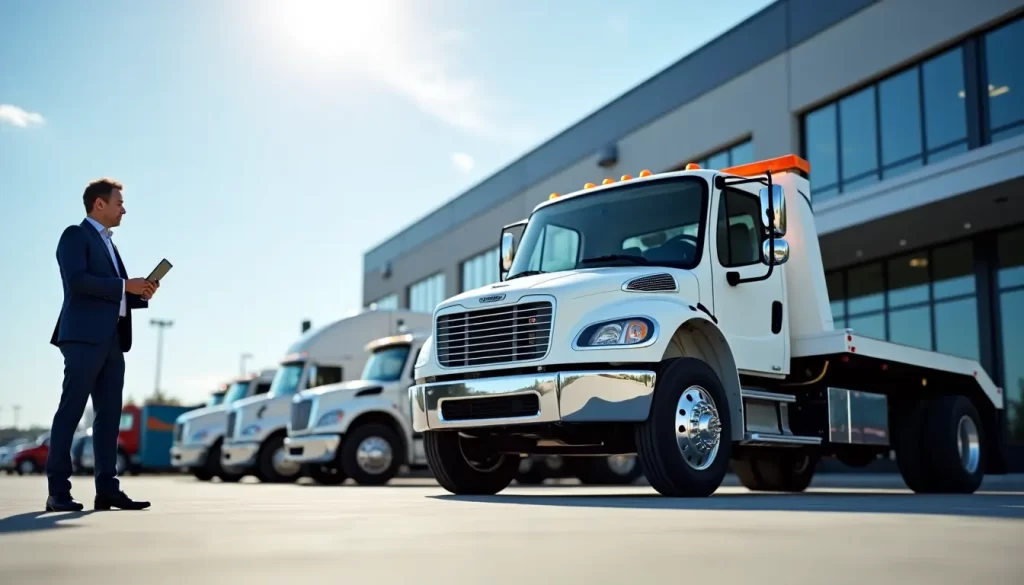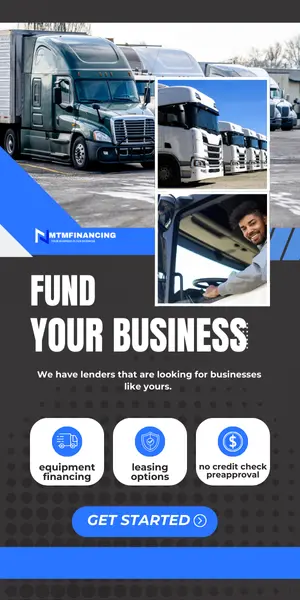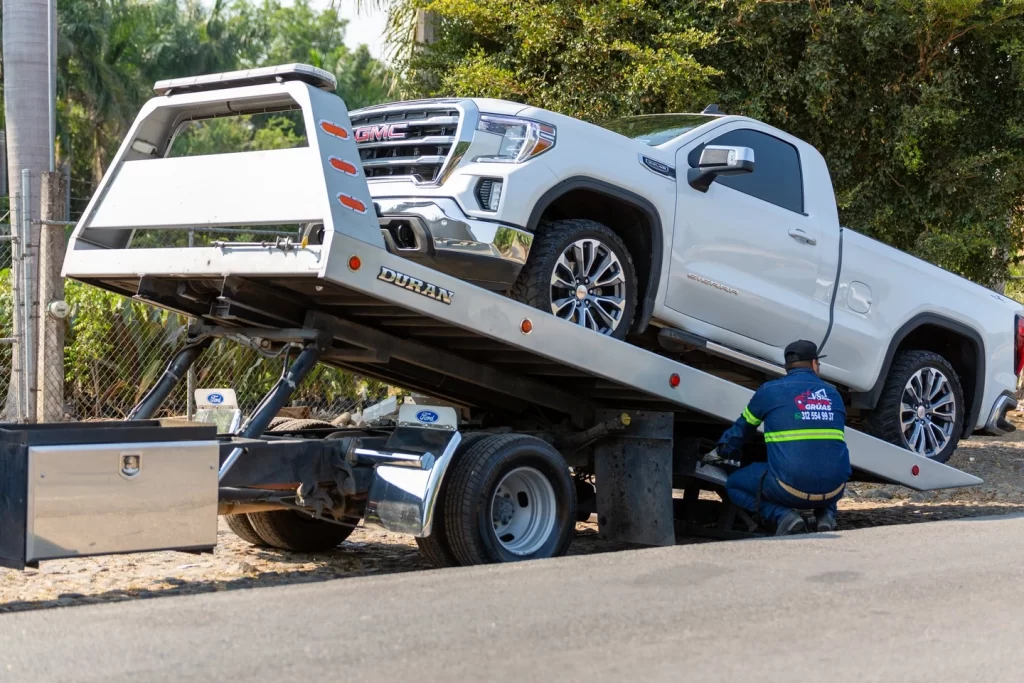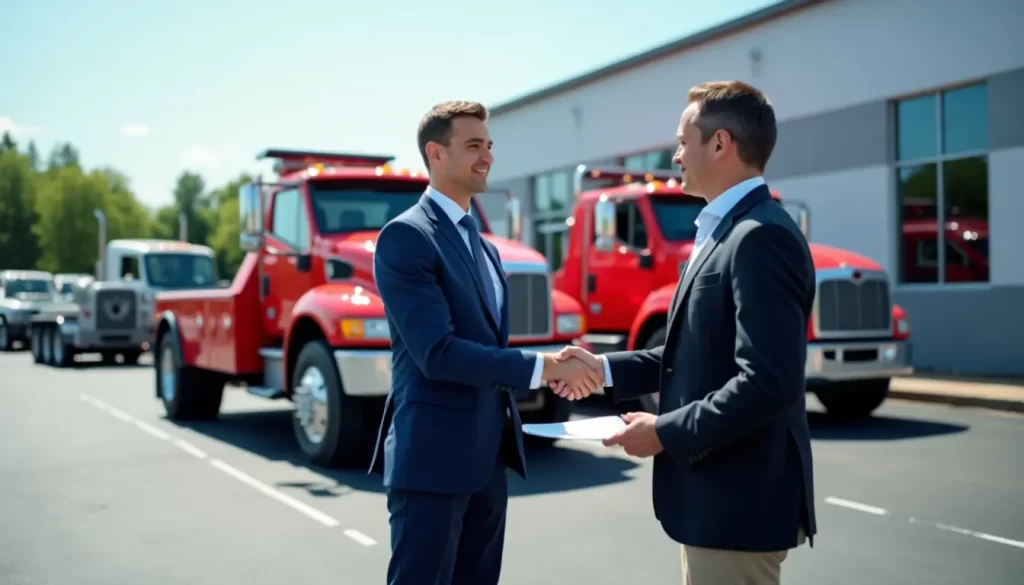Finance Your Tow Truck With The Right Lender
Bank loans are hard to get approved for. We build relationships with commercial lending partners who are looking to fund businesses like yours.
- 100% Guaranteed Equipment Lenders
- Easy Online Process
- Financing, Leasing & Multiple Loan Options


Tow Truck Financing Financing A New Or Used Tow Truck
There are a few different ways you can purchase a tow truck for your business. Here you will discover a few financing options and what you need to know.
In this post, we’ll unpack everything you need to know about tow truck financing.
From understanding your options and qualifying for loans to comparing providers and avoiding common pitfalls, we’ve got you covered.
Understanding Tow Truck Financing Options
Traditional bank loans
Traditional bank loans are a common financing option for tow truck businesses.
These loans offer competitive interest rates and longer repayment terms, making them attractive for established companies with strong credit histories. Here’s a breakdown of the key features:
Lower interest rates compared to alternative lenders
Longer repayment terms, often 5-10 years
Requires collateral, typically the tow truck itself
Stricter credit requirements and longer approval process
| Pros | Cons |
|---|---|
| Lower interest rates | Stricter credit requirements |
| Longer repayment terms | Longer approval process |
| Established lender relationships | May require additional collateral |
Equipment financing
Equipment financing is tailored specifically for purchasing tow trucks and related equipment.
This option allows businesses to spread the cost of the truck over time while using it to generate revenue. Key points include:
Financing up to 100% of the tow truck’s value
The truck serves as collateral, reducing risk for the lender
Faster approval process compared to traditional bank loans
Potential tax benefits through depreciation deductions
SBA loans
Small Business Administration (SBA) loans are government-backed financing options that can be used for tow truck purchases. These loans offer:
Lower down payments and longer repayment terms
Competitive interest rates
Flexibility in use of funds (e.g., purchasing multiple trucks or additional equipment)
More lenient credit requirements compared to traditional bank loans
Leasing options
Leasing provides an alternative to purchasing a tow truck outright.
This option can be beneficial for businesses looking to conserve cash flow or frequently upgrade their equipment. Consider these points:
Lower upfront costs compared to purchasing
Potential tax advantages through deductible lease payments
Easier to upgrade to newer models at the end of the lease term
May have higher long-term costs compared to ownership
When choosing a financing option, consider your business’s financial situation, credit history, and long-term goals.
Each option has its own advantages and drawbacks, so it’s essential to carefully evaluate which best suits your needs.
Benefits of Tow Truck Financing

Preserve working capital
Tow truck financing offers a significant advantage by allowing you to preserve your working capital.
Instead of depleting your cash reserves to purchase a tow truck outright, financing enables you to spread the cost over time.
This approach ensures that you maintain sufficient liquidity for day-to-day operations, unexpected expenses, and potential growth opportunities.
Here’s a breakdown of how preserving working capital benefits your towing business:
| Benefit | Description |
|---|---|
| Emergency Fund | Maintain cash reserves for unexpected repairs or slow periods |
| Operational Flexibility | Have funds available for fuel, maintenance, and employee wages |
| Growth Opportunities | Capitalize on business expansion or marketing initiatives |
| Improved Cash Flow | Better manage monthly expenses with predictable payments |
Tax advantages
Financing your tow truck can offer substantial tax benefits. In many cases, you can deduct the interest paid on your loan and depreciation expenses from your taxable income. This can lead to significant savings come tax season.
Upgrade equipment regularly
With financing, you have the flexibility to upgrade your tow truck fleet more frequently.
This ensures that you’re always operating with the latest technology and most efficient equipment, which can:
Improve fuel efficiency
Reduce maintenance costs
Enhance safety features
Increase towing capacity
Expand business operations
Tow truck financing facilitates business growth by allowing you to:
Add more vehicles to your fleet
Hire additional drivers
Expand your service area
Offer new towing services
By leveraging financing, you can seize growth opportunities without compromising your financial stability.
This strategic approach enables you to scale your towing business more effectively and compete in a rapidly evolving industry.
Credit score requirements
When qualifying for tow truck financing, your credit score plays a crucial role.
Lenders typically look for scores above 600, with some preferring 650 or higher.
Here’s a breakdown of how credit scores can affect your financing options:
| Credit Score Range | Financing Possibilities |
|---|---|
| 750+ | Best rates and terms |
| 700-749 | Good rates, multiple options |
| 650-699 | Average rates, fewer options |
| 600-649 | Higher rates, limited options |
| Below 600 | May require alternative financing |
Business history and revenue
Lenders want to see a stable business with consistent revenue. Key factors include:
Length of time in business (typically 2+ years preferred)
Annual revenue (usually $100,000+ for better terms)
Profit margins and cash flow stability
Collateral considerations
Tow trucks themselves often serve as collateral, but additional assets may strengthen your application:
Other business vehicles or equipment
Real estate (business or personal)
Business inventory
Industry experience
Your expertise in the towing industry can significantly impact your financing approval:
Years of experience in towing or related fields
Relevant certifications or licenses
Industry affiliations or memberships
Lenders view industry experience as a indicator of your ability to succeed and repay the loan.
Demonstrating a thorough understanding of the towing business, including market trends and operational challenges, can enhance your credibility and improve your chances of securing favorable financing terms.
Comparing Tow Truck Financing Providers

Banks vs. specialized lenders
When comparing tow truck financing providers, it’s essential to understand the differences between banks and specialized lenders. Here’s a breakdown of their key features:
| Feature | Banks | Specialized Lenders |
|---|---|---|
| Interest rates | Generally lower | May be higher |
| Approval process | Longer, more stringent | Faster, more flexible |
| Industry knowledge | Limited | Extensive |
| Loan terms | Less flexible | More tailored options |
| Collateral requirements | Stricter | Often more lenient |
Banks typically offer lower interest rates but have a more rigorous approval process.
Specialized lenders, on the other hand, understand the tow truck industry better and can provide more tailored solutions.
Online lenders
Online lenders have revolutionized the tow truck financing landscape. They offer:
Quick application processes
Faster approval times
Competitive rates
24/7 accessibility
However, be cautious of potentially higher interest rates and shorter repayment terms compared to traditional lenders.
Manufacturer financing programs
Many tow truck manufacturers offer their own financing programs, which can be advantageous for buyers. These programs often include:
Special promotional rates
Flexible payment plans
Bundle deals (truck + equipment)
Extended warranties
While manufacturer financing can be convenient, it’s crucial to compare their offers with other financing options to ensure you’re getting the best deal.
Consider factors such as interest rates, loan terms, and any potential limitations on truck customization or usage.
Tips for Securing the Best Tow Truck Financing Deal
Improve credit score
Before applying for tow truck financing, focus on improving your credit score.
A higher credit score can lead to better interest rates and more favorable terms. Here are some strategies to boost your credit:
Pay bills on time
Reduce credit card balances
Avoid applying for new credit
Dispute any errors on your credit report
Prepare a solid business plan
A well-crafted business plan demonstrates your commitment and increases your chances of securing financing. Include the following elements:
| Section | Description |
|---|---|
| Executive Summary | Brief overview of your tow truck business |
| Market Analysis | Research on local demand and competition |
| Financial Projections | Estimated revenue, expenses, and profitability |
| Marketing Strategy | Plans to attract and retain customers |
Shop around for rates
Don’t settle for the first offer you receive. Compare rates from multiple lenders to find the best deal:
Traditional banks
Online lenders
Specialized equipment financing companies
Credit unions
Negotiate terms
Once you’ve found a potential lender, don’t be afraid to negotiate. Consider discussing:
Interest rates
Repayment period
Prepayment penalties
Collateral requirements
Consider down payment options
A larger down payment can lead to better terms and lower monthly payments. Evaluate your options:
Save up for a substantial down payment
Use existing assets as collateral
Explore trade-in options for older equipment
By following these tips, you’ll be better positioned to secure the best possible financing deal for your tow truck business.
Remember, thorough preparation and careful consideration of your options can make a significant difference in the long-term success of your venture.
Common Pitfalls in Tow Truck Financing

Hidden fees and charges
When securing tow truck financing, it’s crucial to be aware of potential hidden fees and charges that can significantly impact your overall costs. These unexpected expenses can include:
Origination fees
Processing fees
Late payment penalties
Early repayment fees
To avoid surprises, always ask for a comprehensive breakdown of all costs associated with the loan. Here’s a comparison of common hidden fees:
| Fee Type | Typical Range | Impact on Loan |
|---|---|---|
| Origination | 1-5% of loan amount | Increases upfront costs |
| Processing | $100-$500 | Adds to initial expenses |
| Late Payment | 2-5% of payment amount | Increases overall debt |
| Early Repayment | 1-3% of remaining balance | Discourages early payoff |
Inflexible repayment terms
Rigid repayment schedules can cause financial strain, especially in seasonal businesses. Look for lenders offering:
Flexible payment options
Seasonal adjustments
Interest-only periods
Overextending financial commitments
It’s tempting to finance the most advanced tow truck, but overextending can lead to financial distress. Consider:
Your current financial situation
Projected income
Operating costs
Emergency fund needs
Ignoring the fine print
Carefully review all loan documents. Pay attention to:
Interest rate fluctuations
Collateral requirements
Default consequences
Prepayment penalties
By understanding these common pitfalls, you can make informed decisions and secure a tow truck financing deal that aligns with your business needs and financial capabilities.
